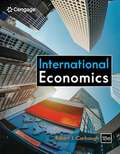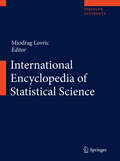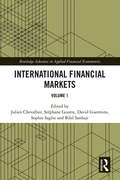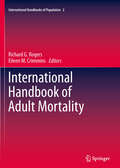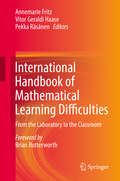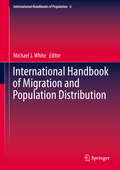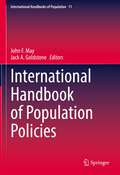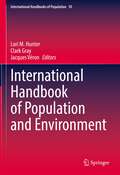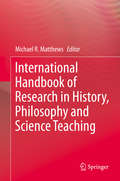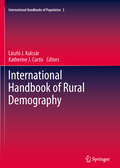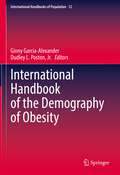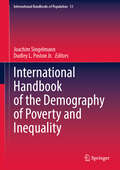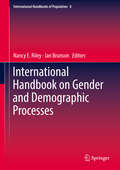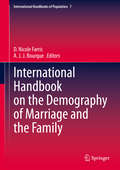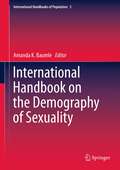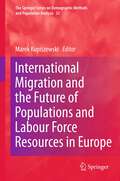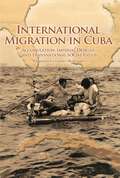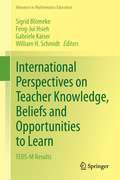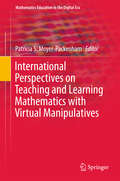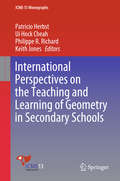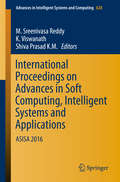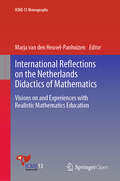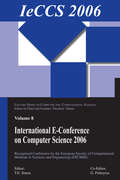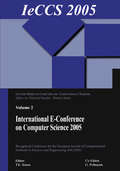- Table View
- List View
International Economics
by Robert J. CarbaughDiscover why Carbaugh's best-selling INTERNATIONAL ECONOMICS, 18E is a favorite among students of all backgrounds for its clear, concise presentation of international trade and finance theory. This edition uses the latest examples from around the world as well as updated, practical applications to vividly demonstrate the relevance of the theory you are learning. You see how the concepts you are mastering apply to today's economic issues and global policy questions as you examine the economic impact of events such as Brexit, China's forced technology transfer, China's Belt Road initiative, the U.S.-Mexico-Canada agreement and the global pandemic. Written and visually driven discussions make content understandable even if you have little economics background. This edition is organized around five themes that emphasize global economics and trade issues. This streamlined presentation is clear, concise and contemporary with award-winning author Dr. Carbaugh.
International Encyclopedia of Statistical Science
by Miodrag LovricThe goal of this book is multidimensional: a) to help reviving Statistics education in many parts in the world where it is in crisis. For the first time authors from many developing countries have an opportunity to write together with the most prominent world authorities. The editor has spent several years searching for the most reputable statisticians all over the world. International contributors are either presidents of the local statistical societies, or head of the Statistics department at the main university, or the most distinguished statisticians in their countries. b) to enable any non-statistician to obtain quick and yet comprehensive and highly understandable view on certain statistical term, method or application c) to enable all the researchers, managers and practicioners to refresh their knowledge in Statistics, especially in certain controversial fields. d) to revive interest in statistics among students, since they will see its usefulness and relevance in almost all branches of Science.
International Financial Markets: Volume 1 (Routledge Advances in Applied Financial Econometrics)
by Julien Chevallier Stéphane Goutte David Guerreiro Sophie Saglio Bilel SanhajiThis book provides an up-to-date series of advanced chapters on applied financial econometric techniques pertaining the various fields of commodities finance, mathematics & stochastics, international macroeconomics and financial econometrics. International Financial Markets: Volume I provides a key repository on the current state of knowledge, the latest debates and recent literature on international financial markets. Against the background of the "financialization of commodities" since the 2008 sub-primes crisis, section one contains recent contributions on commodity and financial markets, pushing the frontiers of applied econometrics techniques. The second section is devoted to exchange rate and current account dynamics in an environment characterized by large global imbalances. Part three examines the latest research in the field of meta-analysis in economics and finance. This book will be useful to students and researchers in applied econometrics; academics and students seeking convenient access to an unfamiliar area. It will also be of great interest established researchers seeking a single repository on the current state of knowledge, current debates and relevant literature.
International Handbook of Adult Mortality
by Eileen M. Crimmins Richard G. RogersThis handbook presents a comprehensive and up-to-date overview of unprecedented substantive, theoretical, methodological, and statistical developments and insights, and an in-depth examination of trends and patterns, in adult mortality around the world. With over two dozen chapters and more than 50 authors, this volume draws from top international mortality experts to provide one of the best overviews of life expectancy extant. The book documents remarkable gains in life expectancy, which stand out as one of the most important accomplishments of the twentieth century. Individuals in more developed countries can expect to live longer now than ever before, especially the Japanese who enjoy record-setting life expectancies. The book also explores unfortunate declines in life expectancy in selected countries brought on by such factors as infectious diseases; accidents, suicides, and homicides; and political and economic conflict and turmoil. This book synthesizes the wealth of mortality information available, clearly articulates the central findings to-date, identifies the most appropriate datasets and methods currently available, illuminates the central research questions, and develops an agenda to address these research questions. The authors carefully examine central factors related to mortality, including health behaviors, socioeconomic status, social relations, biomarkers, and genetic factors. The book will prove especially relevant to researchers, students, and policy makers within social and health sciences who want to better understand international trends and patterns in adult mortality.
International Handbook of Mathematical Learning Difficulties: From the Laboratory to the Classroom
by Pekka Räsänen Annemarie Fritz Vitor Geraldi HaaseThis comprehensive volume provides teachers, researchers and education professionals with cutting edge knowledge developed in the last decades by the educational, behavioural and neurosciences, integrating cognitive, developmental and socioeconomic approaches to deal with the problems children face in learning mathematics.The neurocognitive mechanisms and the cognitive processes underlying acquisition of arithmetic abilities and their significance for education have been the subject of intense research in the last few decades, but the most part of this research has been conducted in non-applied settings and there’s still a deep discrepancy between the level of scientific knowledge and its implementation into actual educational settings. Now it’s time to bring the results from the laboratory to the classroom. Apart from bringing the theoretical discussions to educational settings, the volume presents a wide range of methods for early detection of children with risks in mathematics learning and strategies to develop effective interventions based on innovative cognitive test instruments. It also provides insights to translate research knowledge into public policies in order to address socioeconomic issues. And it does so from an international perspective, dedicating a whole section to the cultural diversity of mathematics learning difficulties in different parts of the world. All of this makes the International Handbook of Mathematical Learning Difficulties an essential tool for those involved in the daily struggle to prepare the future generations to succeed in the global knowledge society.
International Handbook of Migration and Population Distribution
by Michael J. WhiteThis Handbook offers a comprehensive collection of essays that cover essential features of geographical mobility, from internal migration, to international migration, to urbanization, to the adaptation of migrants in their destinations. Part I of the collection introduces the range of theoretical perspectives offered by several social science disciplines, while also examining the crucial relationship between internal and international migration. Part II takes up methods, ranging from how migration data are best collected to contemporary techniques for analyzing such data. Part III of the handbook contains summaries of present trends across all world regions. Part IV rounds out the volume with several contributions assessing pressing issues in contemporary policy areas. The volume's editor Michael J. White has spent a career studying the pattern and process of internal and international migration, urbanization and population distribution in a wide variety of settings, from developing societies to advanced economies. In this Handbook he brings together contributors from all parts of the world, gathering in this one volume both geographical and substantive expertise of the first rank. The Handbook will be a key reference source for established scholars, as well as an invaluable high-level introduction to the most relevant topics in the field for emerging scholars.
International Handbook of Population Policies (International Handbooks of Population #11)
by Jack A. Goldstone John F. MayThis Handbook offers an array of internationally recognized experts’ essays that provide a current and comprehensive examination of all dimensions of international population policies. The book examines the theoretical foundations, the historical and empirical evidence for policy formation, the policy levers and modelling, as well as the new policy challenges. The section Theoretical Foundations reviews population issues today, population theories, the population policies’ framework as well as the linkages between population, development, health, food systems, and the environment. The next section Empirical Evidence discusses international approaches to design and implement population policies on a regional level. The section Policy Levers and Modelling reviews the tools and the policy levers that are available to design, implement, monitor, and measure the impact of population policies. Finally, the section New Policy Challenges examines the recurrent and emerging issues in population policies. This section also discusses prospects for demographic sustainability as well as future considerations for population policies. As such this Handbook provides an important and structured examination of contemporary population policies, their evolution, and their prospects.
International Handbook of Population and Environment (International Handbooks of Population #10)
by Jacques Véron Lori M. Hunter Clark GrayThis handbook presents a timely and comprehensive overview of theory, data, methods and research findings that connect human population dynamics and environmental context. It presents regional summaries of empirical findings on migration and environmental connections and summarizes environmental impacts of migration – such as urbanization and deforestation. It also offers background on the health implications of environmental conditions such as climate change, natural disasters, scarcity of natural resources, as well as on resource scarcity and fertility, gender considerations in population and environment, and the connections between population size, growth, composition and carbon emissions. This handbook helps readers to better understand the complexities within population-environment connections, in addition to some of the opportunities and challenges within environmental demography. As such this collection is an invaluable resource for students, researchers, and policy analysts in the areas of demography, migration, fertility, health and mortality, as well as environmental, global and development studies.
International Handbook of Research in History, Philosophy and Science Teaching
by Michael R. MatthewsThis inaugural handbook documents the distinctive research field that utilizes history and philosophy in investigation of theoretical, curricular and pedagogical issues in the teaching of science and mathematics. It is contributed to by 130 researchers from 30 countries; it provides a logically structured, fully referenced guide to the ways in which science and mathematics education is, informed by the history and philosophy of these disciplines, as well as by the philosophy of education more generally. The first handbook to cover the field, it lays down a much-needed marker of progress to date and provides a platform for informed and coherent future analysis and research of the subject. The publication comes at a time of heightened worldwide concern over the standard of science and mathematics education, attended by fierce debate over how best to reform curricula and enliven student engagement in the subjects. There is a growing recognition among educators and policy makers that the learning of science must dovetail with learning about science; this handbook is uniquely positioned as a locus for the discussion. The handbook features sections on pedagogical, theoretical, national, and biographical research, setting the literature of each tradition in its historical context. It reminds readers at a crucial juncture that there has been a long and rich tradition of historical and philosophical engagements with science and mathematics teaching, and that lessons can be learnt from these engagements for the resolution of current theoretical, curricular and pedagogical questions that face teachers and administrators. Science educators will be grateful for this unique, encyclopaedic handbook, Gerald Holton, Physics Department, Harvard University This handbook gathers the fruits of over thirty years' research by a growing international and cosmopolitan community Fabio Bevilacqua, Physics Department, University of Pavia
International Handbook of Rural Demography
by László J. Kulcsár Katherine J. CurtisThis is the third in an essential series of Springer handbooks that explore key aspects of the nexus between demography and social science. With an inclusive international perspective, and founded on the principles of social demography, this handbook shows how the rural population, which recently dropped below 50 per cent of the world total, remains a vital segment of society living in proximity to much-needed developmental and amenity resources. The rich diversity of rural areas shapes the capacity of resident communities to address far-reaching social, environmental and economic challenges. Some will survive, become sustainable and even thrive, while others will suffer rapid depopulation. This handbook demonstrates how these future development trajectories will vary according to local characteristics including, but not limited to, population composition. The growing complexity of rural society is in part a product of significant international variations in population trends, making this comparative and comprehensive study of rural demography all the more relevant. Collating the latest research on international rural demography, the handbook will be an invaluable aid to policy makers as they try to understand how demographic dynamics depend on the economic, social and environmental characteristics of rural areas. It will also aid researchers assessing the unique factors at play in the rural context and endeavoring to produce meaningful results that will advance policy and scholarship. Finally, the handbook is an ideal text for graduate students in a spread of disciplines from sociology to international development.
International Handbook of the Demography of Obesity (International Handbooks of Population #12)
by Dudley L. Poston Ginny Garcia-AlexanderThis handbook provides a demographic examination of global obesity trends by bringing together the range of research conducted in this field by demographers, sociologists, epidemiologists, and other quantitatively and demographically oriented social scientists. It utilizes a multidisciplinary demographic approach to provide insights into the global prevalence and mechanisms of obesity, as well as the population level impacts of rising obesity. Major sections include: global obesity trends and prevalence; obesity and demographic structures, processes, and characteristics; emerging areas of study; and obesity in LGBAT populations. This handbook provides readers with a broad understanding of population-based research on obesity and serves as a resource for scholars, students, policymakers, and researchers.
International Handbook of the Demography of Poverty and Inequality (International Handbooks of Population #13)
by Dudley L. Poston Jr. Joachim SingelmannThis handbook provides a comprehensive and comparative review of poverty and inequality in developing and developed countries from demographic, sociological, and political perspectives. It discusses, among others, the basics of poverty and inequality, issues of poverty and inequality among race/ethnic and sexual minority subpopulations, social processes, country and comparative perspectives, child poverty, and anti-poverty policies. It also touches on regional disparities. There has been rapid decline in poverty and inequality in China, East Asian and Pacific countries. Declines have also occurred in South Asia. But in Sub-Saharan Africa, poverty and inequality have risen in some countries, while in other regions, such as transition economies in Europe and Central Asia, only modest changes have occurred. This handbook provides a great reference for demographers, social scientists, policy makers and NGOs.
International Handbook on Gender and Demographic Processes (International Handbooks Of Population Ser. #8)
by Jan Brunson Nancy E. RileyThis handbook presents a comprehensive and up-to-date overview of gender in demography, addressing the many different influences of gender that arise from or influence demographic processes. It collects in one volume the key issues and perspectives in this area, whereby demography is broadly defined. The purpose in casting a wide net is to cover the range of work being done within demography, but at the same time to open up our perspectives to neighboring fields to encourage better conversations around these issues.The chapters in this handbook carefully document definition and measurement issues, and take up parts of the demographic picture and focus on how gender plays a role in outcomes. In other cases, gender often plays a cross-cutting role in social processes; rather than having a single or easily distinguishable role, it often combines with other social institutions and even other statuses and inequalities to affect outcomes. Thus, a key factor in this volume is how gender interacts with race/ethnicity, class, nationality, and sexuality in any demographic setting.While each section contains chapters that are broad overviews of the current state of knowledge and behavior, the handbook also includes chapters that focus on specific cultures or events in order to examine how gender operates in a particular circumstance.
International Handbook on the Demography of Marriage and the Family (International Handbooks of Population #7)
by Karista K. Hughes Elizabeth Harmon ThreattThis handbook provides a global perspective on contemporary demographic theories and studies of marriage and the family. Inside, readers will find a comprehensive analysis that enables demographic comparison between and across international borders. Coverage is centered around four main sections that present a history of marriage and the family, detail relevant data and measurement concerns, examine global marriage practices, analyze interactions of such demographic characteristics as age, sex, and race with marriage and the family, and consider public policy, contemporary trends, and future directions. In addition, the book includes research on current social issues such as alternative family structures, cohabitation, divorce, boomerang children, and adoption. The family is universal but extremely varied in form and function. This handbook provides students, researchers, and policymakers with an all-inclusive, international demographic analysis that fully investigates the diverse nature of the modern family.
International Handbook on the Demography of Sexuality
by Amanda K. BaumleThe International Handbook on the Demography of Sexuality is the first book to specifically address the study of sexuality from a demographic perspective. Demographic research has largely paid little attention to sexuality as a whole, or sexual orientation in particular, other than in studies examining the "consequences" of sex - sexually transmitted infections or fertility. Instead, the content of this handbook explores population sexuality in order to describe the prevalence of sexual behaviors, desires, and identities, as well as their connections with other demographic outcomes. The focus is on analyzing sexuality as a demographic topic in its own right, rather than solely as a variable in studies of sexually transmitted infection or other health-related topics. In this book, both researchers with traditional demographic backgrounds, as well as those with training in other disciplines, provide an overview of the state of current research on population sexuality. These chapters provide a foundation for the development of research in the burgeoning field of the demography of sexuality.
International Migration and the Future of Populations and Labour in Europe
by Marek KupiszewskiThe changes of populations are determined by fertility, mortality and migration. On the national level, international migration is a factor of increasing demographic, economic, social and political importance. This book addresses the debate on the impact of international migration and economic activity on population and labour force resources in future. It presents a study conducted for 27 European countries, looking 50 years ahead (2002-2052). An extended discussion of theories and factors underlying the assumed evolution of the components of change and economic activity is included as well as a detailed analysis of the historical trends. These theoretical and empirical considerations lead to defining scenarios of future mortality, fertility, economic activity and international migration, which have been fed into a projection model, producing various future population dynamics and labour force trajectories. In addition, simulations have been made to estimate the size of replacement migration needed to maintain selected demographic and labour market parameters in the countries of Europe. The results presented in this book allow researchers, governments and policy makers to evaluate to what extent various migration and labour market policies may be instrumental in achieving the desired population and labour size and structures. The secondary purpose of this volume is to reveal the methodology and argumentation lying behind a complex population forecasting and simulation exercise, which is not done frequently, but is critical for the assessment of the forecasts and also valuable from a purely didactic point of view.
International Migration in Cuba: Accumulation, Imperial Designs, and Transnational Social Fields
by Alejandro Portes Margarita Cervantes-RodríguezSince the arrival of the Spanish conquerors at the beginning of the colonial period, Cuba has been hugely influenced by international migration. Between 1791 and 1810, for instance, many French people migrated to Cuba in the wake of the purchase of Louisiana by the United States and turmoil in Saint-Domingue. Between 1847 and 1874, Cuba was the main recipient of Chinese indentured laborers in Latin America. During the nineteenth century as a whole, more Spanish people migrated to Cuba than anywhere else in the Americas, and hundreds of thousands of slaves were taken to the island. The first decades of the twentieth century saw large numbers of immigrants and temporary workers from various societies arrive in Cuba. And since the revolution of 1959, a continuous outflow of Cubans toward many countries has taken place—with lasting consequences.In this book, the most comprehensive study of international migration in Cuba ever undertaken, Margarita Cervantes-Rodríguez aims to elucidate the forces that have shaped international migration and the involvement of the migrants in transnational social fields since the beginning of the colonial period. Drawing on Fernand Braudel’s concept of longue durée, transnational studies, perspectives on power, and other theoretical frameworks, the author places her analysis in a much wider historical and theoretical perspective than has previously been applied to the study of international migration in Cuba, making this a work of substantial interest to social scientists as well as historians.
International Perspectives on Teacher Knowledge, Beliefs and Opportunities to Learn: TEDS-M Results
by Gabriele Kaiser Sigrid Blömeke Feng-Jui Hsieh William H. SchmidtThis book reviews the Teacher Education and Development Study: Learning to Teach Mathematics, which tested 23,000 primary and secondary level math teachers from 16 countries on content knowledge and asked their opinions on beliefs and opportunities to learn.
International Perspectives on Teaching and Learning Mathematics with Virtual Manipulatives
by Patricia S. Moyer-PackenhamThis book explores terminology, frameworks, and research being conducted worldwide on virtual manipulatives. It brings together international authors who provide their perspectives on virtual manipulatives in research and teaching. By defining terminology, explaining conceptual and theoretical frameworks, and reporting research, the authors provide a comprehensive foundation on the study and use of virtual manipulatives for mathematics teaching and learning. This foundation provides a common way for researchers to communicate about virtual manipulatives and build on the major works that have been conducted on this topic. By discussing these big ideas, the book advances knowledge for future research on virtual manipulatives as these dynamic tools move from computer platforms to hand-held, touch-screen, and augmented platforms.
International Perspectives on the Teaching and Learning of Geometry in Secondary Schools (ICME-13 Monographs)
by Keith Jones Patricio Herbst Ui Hock Cheah Philippe R. RichardThis book presents current perspectives on theoretical and empirical issues related to the teaching and learning of geometry at secondary schools. It contains chapters contributing to three main areas. A first set of chapters examines mathematical, epistemological, and curricular perspectives. A second set of chapters presents studies on geometry instruction and teacher knowledge, and a third set of chapters offers studies on geometry thinking and learning. Specific research topics addressed also include teaching practice, learning trajectories, learning difficulties, technological resources, instructional design, assessments, textbook analyses, and teacher education in geometry. Geometry remains an essential and critical topic in school mathematics. As they learn geometry, students develop essential mathematical thinking and visualization skills and learn a language that helps them relate to and interact with the physical world. Geometry has traditionally been included as a subject of study in secondary mathematics curricula, but it has also featured as a resource in out-of-school problem solving, and has been connected to various human activities such as sports, games, and artwork. Furthermore, geometry often plays a role in teacher preparation, undergraduate mathematics, and at the workplace. New technologies, including dynamic geometry software, computer-assisted design software, and geometric positioning systems, have provided more resources for teachers to design environments and tasks in which students can learn and use geometry. In this context, research on the teaching and learning of geometry will continue to be a key element on the research agendas of mathematics educators, as researchers continue to look for ways to enhance student learning and to understand student thinking and teachers’ decision making.
International Proceedings on Advances in Soft Computing, Intelligent Systems and Applications
by K. Viswanath M. Sreenivasa Reddy Shiva Prasad K.M.The book focuses on the state-of-the-art technologies pertaining to advances in soft computing, intelligent system and applications. The Proceedings of ASISA 2016 presents novel and original work in soft computing, intelligent system and applications by the experts and budding researchers. These are the cutting edge technologies that have immense application in various fields. The papers discuss many real world complex problems that cannot be easily handled with traditional mathematical methods. The exact solution of the problems at hand can be achieved with soft computing techniques. Soft computing represents a collection of computational techniques inheriting inspiration from evolutionary algorithms, nature inspired algorithms, bio-inspired algorithms, neural networks and fuzzy logic.
International Reflections on the Netherlands Didactics of Mathematics: Visions on and Experiences with Realistic Mathematics Education (ICME-13 Monographs)
by Marja van den Heuvel-PanhuizenThis open access book, inspired by the ICME 13 Thematic Afternoon on “European Didactic Traditions”, takes readers on a journey with mathematics education researchers, developers and educators in eighteen countries, who reflect on their experiences with Realistic Mathematics Education (RME), the domain-specific instruction theory for mathematics education developed in the Netherlands since the late 1960s. Authors from outside the Netherlands discuss what aspects of RME appeal to them, their criticisms of RME and their past and current RME-based projects. It is clear that a particular approach to mathematics education cannot simply be transplanted to another country. As such, in eighteen chapters the authors describe how they have adapted RME to their individual circumstances and view on mathematics education, and tell their personal stories about how RME has influenced their thinking on mathematics education.
International Relations Theory: The Game-Theoretic Approach
by Andrew H. KyddWritten for advanced undergraduate and graduate students, this is the first textbook on international relations theory to take a specifically game-theoretic approach to the subject, and provide the material needed for students to understand the subject thoroughly, from its basic foundations to more complex models. International relations theory is presented and analysed using simple games, which allow students to grasp the concepts and mechanisms involved with the rationalist approach without the distraction of complicated mathematics. Chapter exercises reinforce key concepts and guide students to extend the models discussed. Drawing examples from international security, international political economy, and environmental negotiations, this introductory textbook examines a broad array of topics in international relations courses, including state preferences, normal form games, bargaining, uncertainty and communication, multilateral cooperation, and the impact of domestic politics.
International e-Conference of Computer Science 2006: Additional Papers from ICNAAM 2006 and ICCMSE 2006
by Theodore Simos Georgios PsihoyiosLecture Series on Computer and on Computational Sciences (LSCCS) aims to provide a medium for the publication of new results and developments of high-level research and education in the field of computer and computational science.In this series, only selected proceedings of conferences in all areas of computer science and computational sciences wil
International e-Conference on Computer Science (IeCCS 2005)
by Theodore SimosThe aim of IeCCS 2005, which was held in May 2005, was to bring together leading scientists of the international Computer Science community and to attract original research papers. This volume in the Lecture Series on Computer and Computational Sciences contains the extended abstracts of the presentations. The topics covered included (but were not limited to): Numerical Analysis, Scientific Computation, Computational Mathematics, Mathematical Software, Programming Techniques and Languages, Parallel Algorithms and its Applications, Symbolic and Algebraic Manipulation, Analysis of Algorithms, Problem Complexity, Mathematical Logic, Formal Languages, Data Structures, Data Bases, Information Systems, Artificial Intelligence, Expert Systems, Simulation and Modeling, Computer Graphics, Software Engineering, Image Processing, Computer Applications, Hardware, Computer Systems Organization, Software, Data, Theory of Computation, Mathematics of Computing, Information Systems, Computing Methodologies, Computer Applications and Computing Milieu.
